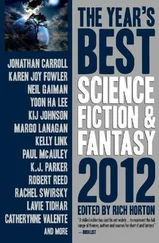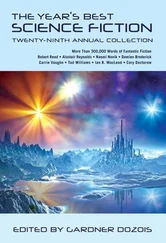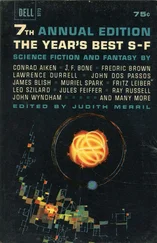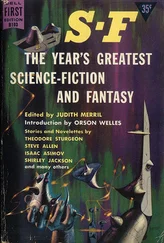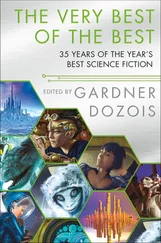Judith Merril - The Year's Greatest Science Fiction & Fantasy 6
Здесь есть возможность читать онлайн «Judith Merril - The Year's Greatest Science Fiction & Fantasy 6» весь текст электронной книги совершенно бесплатно (целиком полную версию без сокращений). В некоторых случаях можно слушать аудио, скачать через торрент в формате fb2 и присутствует краткое содержание. Год выпуска: 1962, Издательство: Dell, Жанр: Фантастика и фэнтези, на английском языке. Описание произведения, (предисловие) а так же отзывы посетителей доступны на портале библиотеки ЛибКат.
- Название:The Year's Greatest Science Fiction & Fantasy 6
- Автор:
- Издательство:Dell
- Жанр:
- Год:1962
- ISBN:нет данных
- Рейтинг книги:3 / 5. Голосов: 1
-
Избранное:Добавить в избранное
- Отзывы:
-
Ваша оценка:
- 60
- 1
- 2
- 3
- 4
- 5
The Year's Greatest Science Fiction & Fantasy 6: краткое содержание, описание и аннотация
Предлагаем к чтению аннотацию, описание, краткое содержание или предисловие (зависит от того, что написал сам автор книги «The Year's Greatest Science Fiction & Fantasy 6»). Если вы не нашли необходимую информацию о книге — напишите в комментариях, мы постараемся отыскать её.
The Year's Greatest Science Fiction & Fantasy 6 — читать онлайн бесплатно полную книгу (весь текст) целиком
Ниже представлен текст книги, разбитый по страницам. Система сохранения места последней прочитанной страницы, позволяет с удобством читать онлайн бесплатно книгу «The Year's Greatest Science Fiction & Fantasy 6», без необходимости каждый раз заново искать на чём Вы остановились. Поставьте закладку, и сможете в любой момент перейти на страницу, на которой закончили чтение.
Интервал:
Закладка:
Suppose we get a new space drive within the next few years. What will be the consequences? What will be the impact of this upon the world political situation if it is discovered in America? In Russia? In Switzerland? In Spain? What is going to happen to a space exploration program built around rocket engines?
Suppose it is a true anti-gravity machine; what’s going to happen to the chief helicopter designer at Offwego Aircraft Company?
This is downright serious stuff, not fantasy, because the trend curve says that something is going to happen. Consideration of all the varied aspects of this is a proper, legitimate, and professed job for science-fiction. It is the only medium of communication by which this can truly be considered in advance,. Get busy; something’s going to happen damned soon to keep the speed curve rising.
The speed curve isn’t the only one that is going up fast. All trend curves are now rising rapidly, and all of them go asymptotic before 2000 a.d. Here are a few of them, plus some things to think about:
1. Life expectancy is increasing, and this trend curve indicates that anyone born after the year 2000 a.d. lives forever, barring accidents. Recent Russian biological work indicates how this may be achieved, but regardless of the method what are the implications? Should my grandson buy life insurance or accident insurance? In fact, what is going to happen to the life insurance business? How will all of this affect the practice of medicine, and how will the medical arts be changed as a result of the knowledge that permits longevity? Heinlein tackled one aspect of this in “Methuselah’s Children,” but what are some of the other aspects of the problem? If a man can live for a thousand years, does this make interstellar travel at sub-light speeds practical? And how much can a man learn in a thousand years?
2. Population is rising rapidly, and early in the Twenty-first Century there isn’t enough room on the planet Earth for everybody. This curve shows no more signs of leveling off than the other trend curves do, so we cannot take the easy way out via starvation, birth control, or mass destruction, because those things are apparently not in the cards when other trend curves are also considered. Can we export people to other worlds fast enough? Isaac Asimov says we can’t, and Dandridge M. Cole says we can... and both can back up their arguments with calculations. Or is this curve, in connection with other curves, simply telling us to expect an event of major cosmic significance in the next fifty years? If so, what?
3. Historical cycles are getting shorter. Rome rose and fell in about eight centuries, the lifetimes of many men. The British Empire came apart in a matter of years, not centuries. A cultural cycle today is about twenty years long. Soon, we can expect to see several major cultural changes in one life span. This is probably due to the improvement of rapid communication and transportation devices. All right: what are the effects of this upon the individual human being? How adaptable must a man be to withstand this? What sort of a successful human being is likely to result from adaptation to rapid cultural change?
4. The trend curve for controllable energy is rising rapidly. The richest baron of feudal times did not control the same amount of energy in his human serfs and slaves as you have at your command beneath the hood of your automobile. The advent of controlled nuclear energy has boosted that curve even more. It is highly probable that controlled fusion has been achieved in the laboratory and will become commercial within a matter of years, thereby kicking the curve up to an even higher level. By 1981, this trend curve shows that a single man will have available under his control the amount of energy equivalent to that generated by the entire sun. To use an energy source, you must have an energy sink; you must have some place to dissipate the energy in performing work. What are we going to do with this much energy? How are we going to use it? How will this alter our way of life? What can we do then that we can’t do now because we don’t have the energy sources? Unless a man has the proper training, we presently deny him the use of certain forms of packaged high energy such as explosives, nuclear reactors, and highspeed vehicles; what kind of training must a man have before he is allowed to use the energy of a star?
5. The number of circuits in cybernetic devices is increasing on the familiar trend curve. The human brain has an estimated four billion neural circuits. By 1970, computer engineers may have achieved the same number of circuits in a digital computer; they may do this by building one large computer or by slaving many smaller computers together by data links as they have already started to do. The speed of digital computers is quite high, and they are getting faster all the time. What are the logical consequences of this? Will these machines think? Will they repair themselves? Will we finally achieve the ability with these machines to handle problems with extremely large numbers of variables, problems which cannot presently be solved? What problems? Will these machines be used in the manner of Ken Crossen’s SOCIAC, or will we put them to work as tools to help us solve the riddles of biochemistry and psychology? By building complex machines of this type, will we gain a better understanding of our own mental processes, and, if so, what are the consequences? Assume that mankind will not allow itself to be replaced by its own machines, and then consider what steps mankind must take to achieve a dynamic, viable solution to this problem.
6. The amount of knowledge that must be assimilated by our young people before they are equipped to earn a livelihood is also increasing on the super-exponential trend curve along with the curve representing the total accumulated knowledge of the human race. People used to spend only a few years in school learning the three R’s. Now, they must spend at least 12 years in school... or 16 and more if they desire to enter a profession. Question: Must we therefore spend more and more of our lives in school, or have we already reached the point where we must both study and work during our entire lives if we are to keep up with our own field of endeavor? What must we do to our educational system to cope with this? This is more serious than the growing shortage of classroom space and teachers, because there will always be a shortage of these two items from now on; we can’t catch up. But the amount we must learn continues to increase. What sort of educational system can be designed to cope with this?
All of these trend areas have been touched by science-fiction, mostly in a cursory and incomplete fashion, and mostly by extrapolating a single curve to its ultimate limit without consideration of the other curves. In writing such stories, the authors have allowed one factor to advance while everything else stood still. This isn’t the case. All the trends are upward, not just one of them, and any yarn based on a single curve without consideration of the others results in an unrealistic extrapolation toward a non-viable future state of affairs. But writers continue to make this mistake, and competent scientists and managers make the same one when they attempt to chart the future on the basis of extrapolation. In research management or science-fiction writing, one must consider every possible factor, weighing each as to its importance and recognizing that there is a time scale involved, too.
In other words, one says to himself that Gadget A is not possible until Metal B is developed. When Gadget A becomes a reality, Device C results. It is then possible to cross-fertilize this technology with the data now in existence in Science K. We come up with an instrument that will be useful at that time in thrimaline research over there, possibly leading to... In other words, a multi-dimensional array. Organized brainstorming, or cerebral popcorn.
Читать дальшеИнтервал:
Закладка:
Похожие книги на «The Year's Greatest Science Fiction & Fantasy 6»
Представляем Вашему вниманию похожие книги на «The Year's Greatest Science Fiction & Fantasy 6» списком для выбора. Мы отобрали схожую по названию и смыслу литературу в надежде предоставить читателям больше вариантов отыскать новые, интересные, ещё непрочитанные произведения.
Обсуждение, отзывы о книге «The Year's Greatest Science Fiction & Fantasy 6» и просто собственные мнения читателей. Оставьте ваши комментарии, напишите, что Вы думаете о произведении, его смысле или главных героях. Укажите что конкретно понравилось, а что нет, и почему Вы так считаете.


